MuSaBa is an expression – a dream that became a reality, a past looking for a future, and the present finding meaning in its roots. The brainchild of artists Nik Spatari and Hiske Maas, MuSaBa or the Museum Santa Barbara is a concept, a park, a museum and a laboratory located in the foothills of the rugged Aspromonte Mountains in Mammola, Calabria.

Nik Spatari, self-portrait
For almost half a century its protagonists have dedicated themselves to this monumental opus, a work in progress that strives towards “a perfect balance between art, architecture and landscape.” Incredibly, their commitment has even led to arrest and a hunger strike. There was also aggravated arson. Change wasn’t welcomed by everyone in the neglected area, and as the project began to take shape and garner attention, criminal elements on both sides of the law wanted a piece of the action. However, Spatari and Maas triumphed over the unfounded accusations and vicious attacks, and their persistence has paid off.
MuSaBa: A DESTINATION

Ritratto di Hiske, oil on canvas, 1980
The couple transformed a once abandoned seventeen-acre property in an economically struggling zone into a destination for tourists of all ages and nationalities. Driving on the state road that cuts across the tip of Italy’s toe from Rosarno on the Tyrrhenian side to Gioiosa Ionica on the Ionian, MuSaBa can’t be missed. The large sculpture Concetto universale (Universal Concept, 1983) beckons from its hillside position where it can be seen from all over the valley. The “Parco Museo Laboratorio Vivo” or Living Park-Museum-Laboratory is the type of place that might be included in a book or television show focusing on offbeat Roadside Attractions, except for the fact that MuSaBa is not a happenstance drive-by. It is the destination.

“Concetto universale” by Nik Spatari, MuSaBa, Mammola
From individual day-trippers to busloads of excursionists, school classes to university groups, teachers to artists, the complex offers not just a museum and park to be appreciated for a conventional visit but also a laboratory in which participants work alongside Spatari, taking part in the evolution and realization of the founder’s artistic vision. Museum Santa Barbara even has a residence for weekend or longer stays, all conceived and constructed by Spatari and the many students, assistants and artists who have visited over the years.

Foresteria – Hotel at MuSaBa in Mammola, Calabria
MuSaBa: THE INSPRIATION
“Why Mammola?” one may ask. Spatari was born there. Nik is short for Nicodemus, as in Nicodemus of Mammola, the town’s well-known patron saint, who in the 10th century built his monastery in the surrounding territory. Before returning to his home region, Spatari studied in Paris and had a gallery in Milan with his Dutch companion Hiske Maas, herself an artist as well as a manager-entrepreneur. Together they founded the art center in a place that captured their imaginations with its wild, irregular topography and mild Mediterranean climate.

Santa Barbara Church, MuSaBa Park
They called their center Museo Santa Barbara after the Carthusian monastery that once flourished on the spot. Its ruins sat atop those of an early Christian church and a Roman bath. The couple has even found evidence of prehistoric peoples, and the area’s history and the architectural remains play an important role in their work.
MuSaBa: A VISIT

MuSaBa Gate, Mammola
The adventure of a visit to MuSaBa begins upon pulling off the highway and following the vague signage that weaves around the rough road leading to the complex. A metal gate decorated with wild boar blocks further vehicular passage and indicates the start of a footpath that winds under the highway. Colorfully painted concrete road supports and larger than life sculpture give the feel of an overgrown urban park before the path leads up the hill past olive trees and banks of prickly pear cactus to reach Santa Barbara above. Without a clear entrance booth my traveling companion and I wandered until Hiske found us at the gallery.

SaBa Lizard, 2000-01
The exhibition room’s brightly colored mosaic floor pops. Mosaics are featured throughout the complex, both indoors and out – vivid and harmonious. This space is Spatari’s picture gallery. His paintings from a range of years are hung around the perimeter – bold and primitive are words that come to mind, perhaps aggressive at times, with an expressive use of color. Many works are executed in nitrate paint on canvas or wood. The colors are quite intense. The primitive and symbolic morph into the abstract.

Floor of MuSaBa Gallery

Le tre eta’ (The Three Ages), nitrate on canvas, Spatari
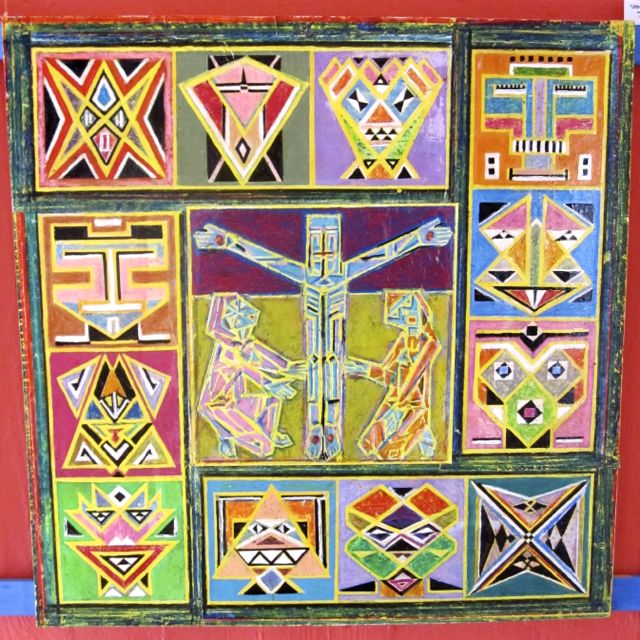
Last Supper and Crucifixion, center panel, nitrate on board, 2011, Spatari
THE SISTINE CHAPEL OF CALABRIA

Nik Spatari, Il Sogno di Giacobbe, MuSaBa
When we completed our viewing of the gallery, Hiske led us to the former Santa Barbara church, which has been restored by the couple along with a few other structures on the property. Here, Spatari has created his monumental Il Sogno di Giacobbe (Jacob’s Dream), a 14×6-meter (46×20-foot) work that covers the entire vaulted ceiling and continues down the apse. Scenes from Jacob’s life seem to jump out at you, all the way from the height of 9 meters (30 feet). Interestingly, Spatari painted the individual images within the episodes on thin pieces of wood shaped to the specific likeness. The reliefs were then attached as though suspended in air. Anatomically detailed nudes – lean, tense bodies acting out the story amidst a swirl of color. Spatari put himself in the role of Jacob, his beard, his expression, and his long torso, achingly depicted in the death scene played out in front of the multicolored bands of his “universal concept.” And throughout, Hiske is clearly his muse.

Il Sogno di Giacobbe, detail of Jacob’s death
“Jacob’s Dream” is dedicated to Michelangelo, “astronaut of the Sistine,” and Calabria’s own Tommaso Campanella, 16-17th-century utopist and author of La città del sole (The City of the Sun), who, “like Nik and Hiske endured the persecution of their time.” The couple’s images do seem to suffer in this work.

Il Sogno di Giacobbe, detail
THE PARK OF CONTEMPORARY ART
Looking out over the park and surrounding valley from Santa Barbara’s elevated position, I didn’t see any of the angst of “Jacob’s Dream.” Walking the grounds, I came across installations by various artists from around the world, my favorite being “Donna Fontana” by American artist Stevi Kerwin. I like the private moment captured in the lighthearted sculpture of the sunbathing “Woman fountain,” although I wouldn’t have minded seeing the water aspect in motion.
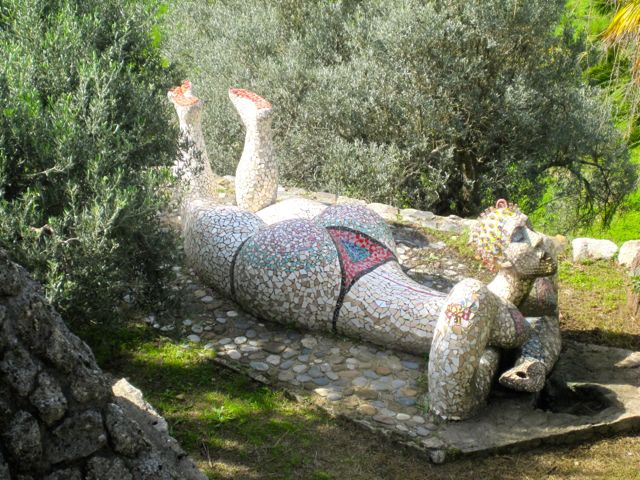
Stevi Kerwin’s “Donna Fontana” 1987
The foresteria or guesthouse is particularly inviting. Its colorful geometric roof with the giant human figure towering from its midst as seen from Santa Barbara is met with an equally appealing vision on the lower level. One of Spatari’s architectural creations, the geometry in the interior of the building makes for a charming funhouse on the inside as well. Bright mosaics cover the walls and continue to be a work in progress.

Mosaics in Progress at MuSaBa
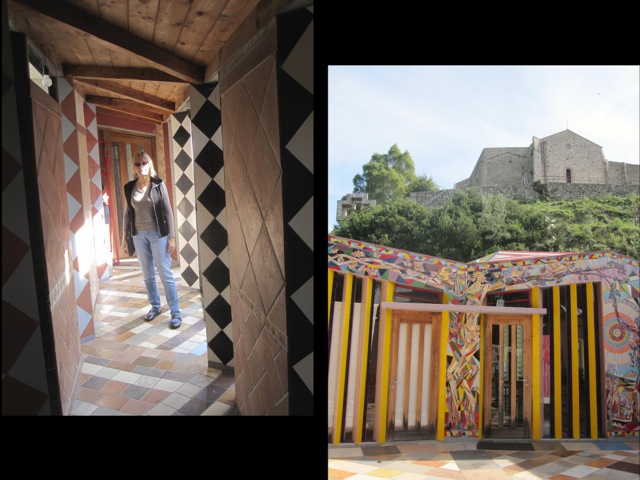
MuSaBa Foresteria – Hotel
In this lower area of the park, Spatari has created a tranquil refuge under the shade of pine trees, embellished with his oversized sculptures. There are also a number of unexpected mischievousnesses on a much smaller scale not to be overlooked, such as in the stone walls of the property.

Stone Wall at MuSaBa
MuSaBa FOUNDATION

Hiske Maas, co-founder MuSaBa
Spatari was away at the launch of an exhibition in Naples during my visit this past fall. As the park is open every day of the year, Hiske was on hand to personally receive visitors. Unobtrusive and soft-spoken, she shared some of the background and challenges regarding MuSaBa’s development. Perhaps the obstacles even served to stimulate their rebellious spirits, inspiring them to overcome and promote artistic activities that would take on a value even greater than their cultural context. MuSaBa continues to move forward with their mission.
Nik Spatari turned 87 this past April 16th. News sources in Calabria took the opportunity to celebrate the artist’s achievements. He has set an example and is looked up to throughout the region. He has had success beyond its borders. Like his sculptures, he has created something larger than life, challenging with the spirit of a pioneer. I would like to have met the man and artist in person, to experience his energy and ideas firsthand. Next time.

Farfalla (Butterfly), 2001, Nik Spatari
Sadly, Nik Spatari passed away on August 24, 2020.
Read more about the town of Mammola and the fascinating Calabrian region in my award-winning book Calabria: The Other Italy, available in paperback and electronic formats. Visit MuSaBa on my new Traditions and Food of Calabria Tour, check out the itinerary on my Calabria Tour page.
See another of Nik Spatari’s works in my blog post Contemporary Interpretations of the Riace Bronzes and other Calabrian artists: A Dream in Terracotta, Arghillà l’arte delle terre of Nicola Tripodi, Textile Artist Domenico Caruso, The Ceramics of Seminara – In the Studio of Enzo Ferraro and An Artist in Amantea.
Experience Mammola’s Festa del Fungo or Mushroom Festival in my blog post Mammola and Mushrooms.
More information, also in Italian, on the Museo Santa Barbara website.
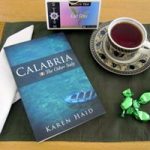 “Like” Calabria: The Other Italy’s Facebook page and follow me on Karen’s Instagram and Karen’s Twitter for more beautiful pictures and information.
“Like” Calabria: The Other Italy’s Facebook page and follow me on Karen’s Instagram and Karen’s Twitter for more beautiful pictures and information.
Sign up below to receive the next blog post directly to your email for free.
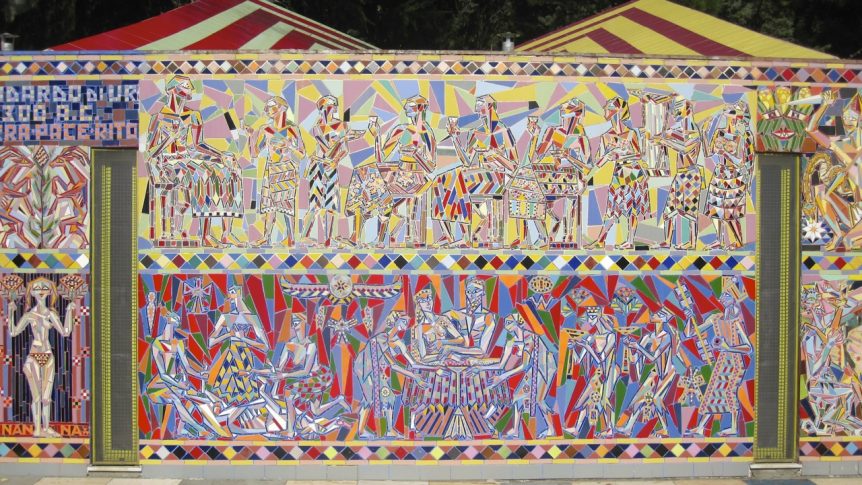
Comments 10
Fascinating and beautiful! Thank you so much for sharing, and warm greetings from Montreal, Canada. 🙂
Author
Nik Spatari is a unique individual and the park he has created is, as you say, fascinating and beautiful. Calabria is full of lovely surprises. Thanks for checking in and best to you in Montreal.
There is somewhat exotic quality about it now, isn’t it?
Author
Yes, the unconventional artist has created and assembled striking works and has designed a very out-of-the-ordinary Park-Museum for their display, resulting in a complete, one-of-a-kind experience for the visitor.
Thanks for commenting.
Our baker in Harrisburg PA USA is a native of Mammola. We had already discussed visiting there. Seeing this place cemented the idea. Hope to be there within the year.
Author
That’s great! I’m going to be there tomorrow for the Mushroom Festival. All the best with your plans.
Love the way you always introduce me to new destinations in Calabria.
My friends in Cosenza have mentioned this spot to me but I haven’t managed to get there yet…
Author
Glad you have another spot to visit. And eat some mushrooms or pescestocco, which the town of Mammal is famous for, while you’re there.
Throughly enjoyed the read
Author
Thanks, MuSaBa is a fascinating place!